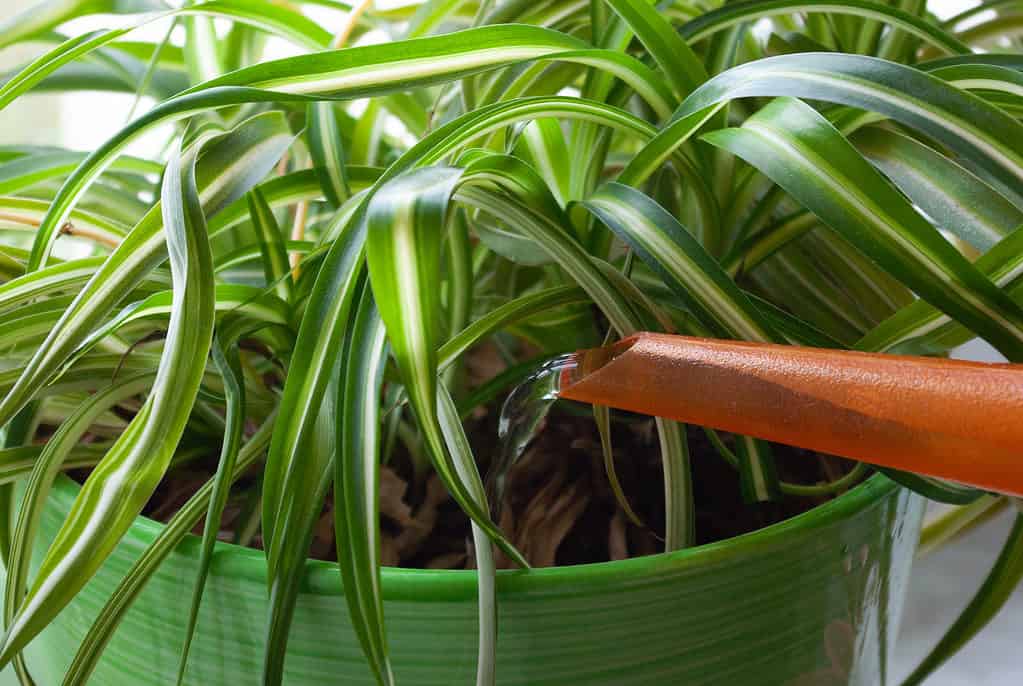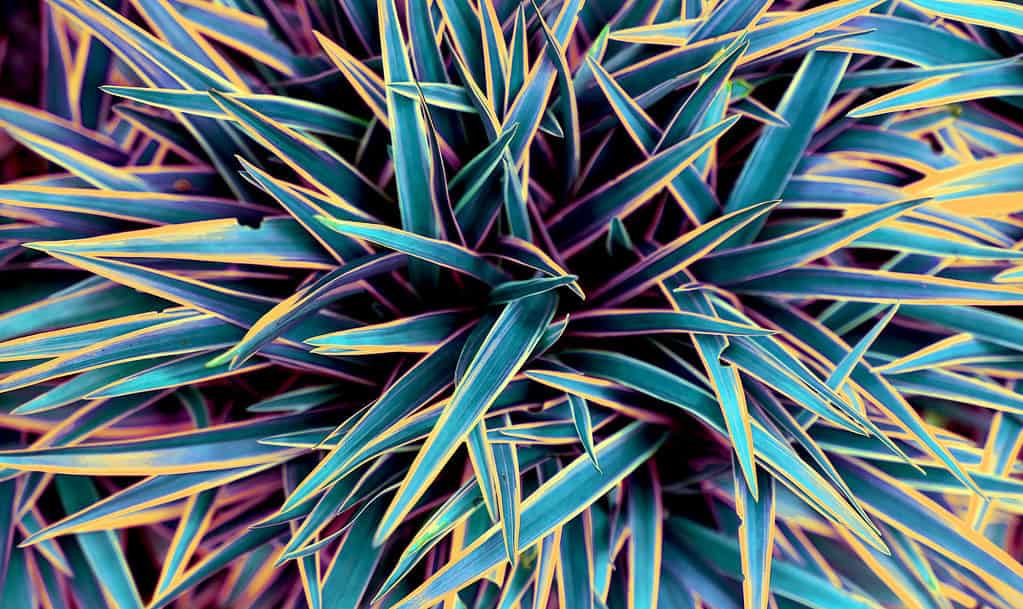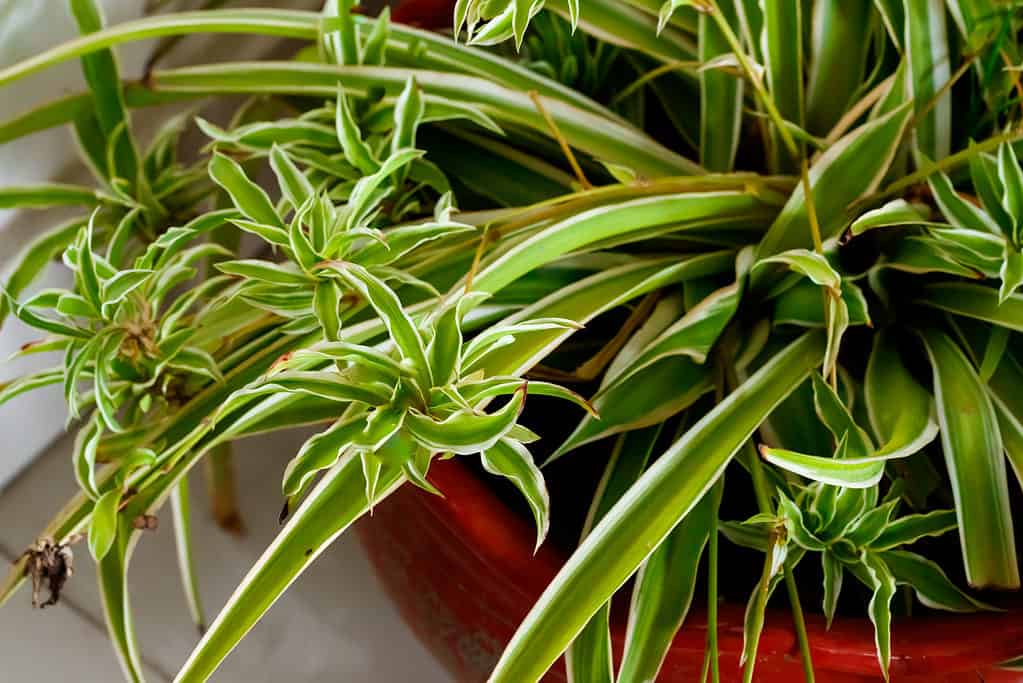The spider plant or aircraft plant, Chlorophytum comosum, is a common houseplant found in homes and workplaces. These lovely houseplants need relatively little upkeep, which is why they are so popular. They may be cultivated under various circumstances, including various lighting levels and climates. Since this plant is non-toxic, it is also well-liked by those with small children, cats, and dogs. Just as well the spider plant was included first on NASA’s list of efficient air cleaners. To put it simply, the spider plant has quite a few benefits in addition to being pretty!
Many inexperienced or beginner spider plant growers aren’t aware of what kind of soil or fertilizer their plants need. Unfortunately, depending on who you ask, you’ll probably receive many different answers on the best soil mix and maintenance practices. Fortunately, there is some general advice on what to use and what to avoid.
What type of soil is required, and what works best for spider plants? In this guide, we’ll take a look at everything you need to know about spider plant soil and fertilizer, from what type of mix works best to how often you should fertilize your beloved plant. We’ll also explain how to make your own soil mix for your spider plant.
Why is the Right Soil Mix Necessary For Spider Plants?
Healthy soil is essential for plant growth, but what function does it truly serve? Soil enables plants to obtain the nutrients, oxygen, moisture, and other components they require for growth and health. The correct soil will support a plant’s roots and guarantee that the environment is ideal for that particular species to thrive.
Additionally, depending on the plant you are attempting to cultivate, different types of soil are needed. For instance, certain plants require a certain pH level, while others need a certain amount of wetness. This is why choosing the proper soil type for indoor plants is important. They may grow robust and live for many years if given the right base. With the incorrect soil, they might struggle to grow or have issues.

Spider plant (pictured) soil that absorbs and drains moisture well is vital for the health of your plant.
©iStock.com/Simplylesia
Spider Plant Soil Factors to Know
These plants are quite heavy root-feeders. As a result, the plant needs a growth medium that is rich in nutrients to flourish. The plants are likely to perish if they don’t receive adequate nutrients from the soil.
The capacity of the soil to drain is another important consideration when choosing soil. Garden soil is one of the heaviest materials; sand doesn’t contain any water at all. As a result, it drains quite slowly. Spider plants prefer well-drained soil that isn’t constantly damp. However, it must also store nutrients for the plant’s growth.
Another important factor to take into account is the soil’s ability to retain moisture. When compared to succulent soil, which doesn’t keep moisture for too long, normal potting soil retains moisture for quite some time. For your spider plants to flourish, it would be great to choose an option somewhere in the middle or even a mix of the two.
Not least among all the important factors that influence the health of the plant is soil aeration. The roots will experience various issues, such as fungal development, root rot, etc., if the soil is compacted too firmly and lacks adequate airflow.
Spider Plant Soil Requirements
Spider plants are robust and adaptable, growing in practically any environment. But not everyone’s plant will flourish and become tall and bushy. For the plant to grow, an adequate growing medium must be provided. Making the ideal potting mixture for your particular plant, however, is not subject to any strict guidelines. Finding the ideal blend is typically a trial-and-error procedure. Making your own soil mixture is really easy and basic. Numerous combinations may be successful for your spider plant.
As a general rule, you should use soil that is well-draining, nutrient-dense, and aerated. This ensures that the soil holds water for a while but doesn’t waterlog your plant. Your soil’s pH level should range from 6.0 to 6.5.
Just as well, the sort of container or planter you use for your spider plant will determine the success of your potting soil. This is because certain containers are better than others at holding moisture. The spider plant species can obtain the moisture and flexibility required for its roots to thrive by placing them in a plastic container with a drainage hole. The best circumstances for this plant require well-draining soil since plastic holds moisture more than other planter materials.

A good potting soil mix results in spider plants (pictured) with vibrant, healthy foliage.
©iStock.com/Prasenjit Kar
The Best DIY Potting Soil for Spider Plants
Make your own top-tier spider plant potting soil by mixing a few items with an existing all-purpose potting soil blend. Choose a current batch of potting or garden soil from your supply or a nearby garden shop to get started. Then, you can include a few other ingredients. These might be vermiculite, peat moss, perlite, or coconut coir. These improvements improve the soil’s aeration and drainage, lowering the possibility of issues with root-based health. Many horticulturists will suggest adding a small amount of each, but you can experiment with different amounts to see what your spider plant prefers. The number of extra ingredients you use may also change depending on the temperature and humidity your spider plant will live in. A low-pH soil mix may also benefit from the addition of limestone or dolomite to raise its pH to the ideal range of 6.0 to 6.5 for the development of a strong spider plant.
Let’s look at a few example recipes for you to try. If your home temperatures and humidity are higher, mix three-quarter organic potting soil, a quart part of perlite, a heaping handful of compost, and a handful of coconut chips. If your home temperatures and humidity tend to be lower, try mixing one part of a succulent soil mix, one part peat moss, one part compost, and a heaping handful of vermiculite.
The Best Commercial Potting Soil for Spider Plants
African violet potting mix is the preferred choice among spider plant specialists if you’d prefer to purchase soil that is ready-made. For your spider plant, African violet potting mixtures are the ideal combination of nutrients, pH, and texture. For anyone looking to get flowers and spiderettes from their spider plant, this type of soil is the finest option. Any peat-based potting mixture will likewise do admirably, but you might find it less optimal than African violet potting mixtures. Regardless of the potting mix you buy, remember always to choose a good container with drainage holes, and never water plants with tap water. Use distilled water or rainwater.
Spider Plant Tips for Fertilizing and Preventing Pests
Spider plants don’t require a lot of fertilizer, especially if the soil is rich or the plant is repotted every year. Pick a balanced liquid home fertilizer and dilute it by half before adding it. From March to September, feed the plant every two to four weeks; richer soils require less frequent feeding than more deficient ones. Your spider plant is dormant between October and February, so avoid feeding it.
Neem cakes can be planted alongside your spider plant if you’re experiencing insect difficulties or anticipate having them in the future. This type of organic insecticide is manufactured from the solid residue left behind after neem oil is extracted. Neem cakes offer additional nutrition. They include traces of organic compounds that are harmless for people and animals, Azadirachtin in particular. This chemical acts as a natural insecticide on the plant. Similar to a good neem soil soak, it also shields the soil and roots from damaging pests and can aid in preventing or treating root rot.

Spider plant (pictured) soil that isn’t ideal may result in brown tips and other ailments.
©iStock.com/niuniu
Do I Need to Have Perfect Potting Soil for My Spider Plant to Thrive?
If you desire flowers or if your spider plant’s health is declining, you will need to be pickier about the type of soil you use. In such circumstances, you should use a high-quality prepared potting mix or create your own. Generally, you may use whatever well-draining potting soil you happen to have on hand or even go with a soilless mix. If your plant is thriving, then the soil you have is likely working just fine.
Am I Using the Wrong Soil?
You are using the incorrect soil mixture for your spider plant if it is not growing properly or if its leaves are browning or withering. In general, spider plants need loamy soil with adequate drainage and lots of organic ingredients.
When to Repot a Spider Plant
Spider plants grow quickly, so you must repot them every year or two. But how will you know when to pot your spider plant again? When spider plants become root-bound, they give out certain visual cues. Being root-bound is indicated by slow growth, roots poking out of the drainage hole, and yellowing or fading of the plant’s leaves. If your spider plant has to be repotted, your pot may also appear to bulge or decay.
As soon as you see any of these symptoms, you must repot your spider plant. But if you could wait till the spring or the first half of the summer, that would be more beneficial for your plant. If the situation is dire and your plant appears to be dying, repot immediately. While repotting plants throughout the autumn and winter may have an adverse effect on their growth because the winter is the plant’s dormant season, leaving a severely root-bound plant to wait to be repotted will result in its death. In order to provide the plants with nutrients to ingest, it is also advisable to remove the old dirt from the pot and replace it with fresh soil.
Spider Plant Repoting Steps
- First, carefully take the spider plant out of its container.
- Examine the roots closely after removing any additional dirt. You can take out the damaged roots before repotting them if you see any indication of root damage.
- Before replanting your spider plant in a new, larger container, give it a good cleaning.
- Usually, a pot that is one size bigger than the current one is adequate. Make sure the pot you’re using has enough drainage holes.
- Position the plant so that you may bury the roots in potting soil.
- Water the plant after repotting it so the potting soil may settle correctly.
And that’s it! Repotting is easy and very good for the longevity and health of your spider plant.
Spider plants are relatively easy to care for, and their soil requirements aren’t that strict. In fact, you have some leeway in terms of soil and fertilizer mixes that your spider plant will tolerate. Just make sure to have a regular watering and fertilizing schedule set up, and you’ll be able to enjoy your lovely spider plant for years to come!
Do you want to learn even more about the incredible and resilient spider plant? Take a look at our complete guide to spider plants here!
The photo featured at the top of this post is © Bozhena Melnyk/Shutterstock.com
Sources
- NCSU Staff, Available here: https://plants.ces.ncsu.edu/plants/chlorophytum-comosum/
- Susan Mahr, Available here: https://hort.extension.wisc.edu/articles/spider-plant-chlorophytum-comosum/
- Brandy Wells, Available here: https://www.petalrepublic.com/best-soil-for-spider-plants/
FAQs (Frequently Asked Questions)
Can succulent soil be used for spider plants?
Spider plants are pretty resilient in any kind of soil. That being said, you will probably have to water your spider plant more often if it is planted in succulent potting mix over regular indoor potting mix.
What type of soil should I plant my spider plant in?
Spider plants do well in any type of soil that is well-draining. Many growers prefer using a mix of potting soil, peat moss, and perlite with a little bit of bone meal.
Can spider plants be grown in just water?
Many plants can endure hydroponics, but the spider plant will usually do better in actual soil instead of just water.
Thank you for reading! Have some feedback for us? Contact the AZ Animals editorial team.







